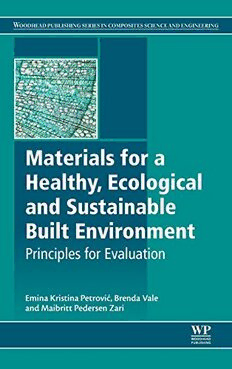
Materials for a Healthy, Ecological and Sustainable Built Environment: Principles for Evaluation PDF
Preview Materials for a Healthy, Ecological and Sustainable Built Environment: Principles for Evaluation
Materials for a Healthy, Ecological and Sustainable Built Environment Related titles Cost-EffectiveEnergyEfficientBuildingRetrofitting:Materials,Technologies,Optimization andCaseStudies (ISBN:978-0-08-101128-7) SustainableConstructionMaterials:CopperSlag (ISBN:978-0-08-100986-4) AdvancedHighStrengthNaturalFibreCompositesinConstruction (ISBN:978-0-08-100411-1) Woodhead Publishing Series in Composites Science and Engineering Materials for a Healthy, Ecological and Sustainable Built Environment Principles for Evaluation Emina Kristina Petrovic´ Brenda Vale Maibritt Pedersen Zari WoodheadPublishingisanimprintofElsevier TheOfficers’MessBusinessCentre,RoystonRoad,Duxford,CB224QH,UnitedKingdom 50HampshireStreet,5thFloor,Cambridge,MA02139,UnitedStates TheBoulevard,LangfordLane,Kidlington,OX51GB,UnitedKingdom Copyright©2017ElsevierLtd.Allrightsreserved. Nopartofthispublicationmaybereproducedortransmittedinanyformorbyanymeans,electronicor mechanical,includingphotocopying,recording,oranyinformationstorageandretrievalsystem,without permissioninwritingfromthepublisher.Detailsonhowtoseekpermission,furtherinformationaboutthe Publisher’spermissionspoliciesandourarrangementswithorganizationssuchastheCopyrightClearance CenterandtheCopyrightLicensingAgency,canbefoundatourwebsite:www.elsevier.com/permissions. ThisbookandtheindividualcontributionscontainedinitareprotectedundercopyrightbythePublisher (otherthanasmaybenotedherein). Notices Knowledgeandbestpracticeinthisfieldareconstantlychanging.Asnewresearchandexperiencebroaden ourunderstanding,changesinresearchmethods,professionalpractices,ormedicaltreatmentmaybecome necessary. Practitionersandresearchersmustalwaysrelyontheirownexperienceandknowledgeinevaluatingand usinganyinformation,methods,compounds,orexperimentsdescribedherein.Inusingsuchinformationor methodstheyshouldbemindfuloftheirownsafetyandthesafetyofothers,includingpartiesforwhomthey haveaprofessionalresponsibility. Tothefullestextentofthelaw,neitherthePublishernortheauthors,contributors,oreditors,assume anyliabilityforanyinjuryand/ordamagetopersonsorpropertyasamatterofproductsliability,negligence orotherwise,orfromanyuseoroperationofanymethods,products,instructions,orideascontainedinthe materialherein. BritishLibraryCataloguing-in-PublicationData AcataloguerecordforthisbookisavailablefromtheBritishLibrary LibraryofCongressCataloging-in-PublicationData AcatalogrecordforthisbookisavailablefromtheLibraryofCongress ISBN:978-0-08-100707-5(print) ISBN:978-0-08-100706-8(online) ForinformationonallWoodheadPublishingpublications visitourwebsiteathttps://www.elsevier.com/books-and-journals Publisher:MatthewDeans EditorialProjectManager:TessaDeRoo ProductionProjectManager:OmerMukthar Designer:InesMariaCruz TypesetbyMPSLimited,Chennai,India Contents Listofcontributors xi Preface:Acallforontologicalconsiderationofbuildingmaterials xiii EminaKristinaPetrovic´ Acknowledgments xvii Introduction xix MaibrittPedersenZari,BrendaValeandEminaKristinaPetrovic´ Part I Selecting Building Materials for Reduced Impacts on Ecosystem Services: Ecosystem Services Analysis 1 1 Utilizingrelationshipsbetweenecosystemservices, builtenvironments,andbuildingmaterials 3 MaibrittPedersenZari 1.1 Introduction:reducingtheenvironmentalimpact ofbuiltenvironments 3 1.2 Ecosystemservices:definitionsandboundaries 4 1.3 Relationshipsbetweenecosystemservices 8 1.4 Definingecosystemservicesforabuiltenvironment context:keyplacesforchange 11 1.5 Descriptionsofecosystemservicesmostapplicable toabuiltenvironment context 17 1.6 Conclusion:ecosystemservicesandthebuiltenvironment. Movingtowardsamorepositiverelationship 21 References 22 2 Ecosystemservicesanalysis:incorporatinganunderstanding ofecosystemservicesintobuiltenvironmentdesignand materialsselection 29 MaibrittPedersenZari 2.1 Introduction:awiderperspectiveonsustainabilityandthebuilt environment 29 2.2 Ecosystemservicesanalysisandwholebuilding orurbandesign 30 2.3 Ecosystemservicesanalysisandmaterialsselection 31 2.4 Benefitsanddifficultiesofapplyingtheecosystem servicesconcepttobuiltenvironmentdesignand materialsselection 40 vi Contents 2.5 Potentialimpactsonecosystemservicesofcommonbuilding materials 41 2.6 Conclusion:Materialsselectionandecosystemservices. Ashiftinthinking 58 References 59 Part II Choosing Sustainable Materials 65 3 Buildingmaterials 67 BrendaVale 3.1 Introduction 67 3.2 Materialsthataregrown 68 3.3 Materialsthatareextracted 77 3.4 Materialsthataremade 84 3.5 Conclusion 105 References 105 4 Materialsandbuildings 113 BrendaVale 4.1 Choosingmaterials 113 4.2 Designingtominimizebuildinglifecycleimpact 119 4.3 Caveat:buildingusers 132 4.4 Choosinghealthyandlow-impactmaterials 133 References 133 Part III Indoor Toxicity from Building Materials 137 5 Alackofrecognitionofpotentialhealthrisksfrombuilding materials 139 EminaKristinaPetrovic´ 5.1 Introduction 139 5.2 Theproblem 140 5.3 Beyondthechallenges:threestagesofrecognitionofhealthrisks 148 5.4 Conclusion 151 References 152 6 Persistingissueswiththemostrecognizedbuildingmaterial healthrisks:leadandasbestos 155 EminaKristinaPetrovic´ 6.1 Introduction 155 6.2 Issueswithlead 155 6.3 Issueswithasbestos 164 6.4 Conclusion 169 References 171 Contents vii 7 Howsubstancesgetregulatedagainstinthebuildingindustry: formaldehyde,phthalateplasticizersinpolyvinylchloride/vinyl 175 EminaKristinaPetrovic´ 7.1 Introduction 175 7.2 Overviewofvolatileorganiccompounds 175 7.3 Issueswithformaldehyde 178 7.4 Issueswithvinyl,polyvinylchloride,andplasticizers 182 7.5 Conclusion 186 References 187 8 Newandlessrecognizedriskswithbuildingmaterials:volatile organiccompounds,replacementchemicals,andnanoparticles 191 EminaKristinaPetrovic´ 8.1 Introduction 191 8.2 On-goingsuspicion—volatileorganiccompoundsfromcarpets 191 8.3 Replacement andnewsubstances 197 8.4 DiscussiononStage1andconclusion 199 References 200 9 Anoverviewofhealthhazardsfrommaterials: Applicationofprinciples 203 EminaKristinaPetrovic´ 9.1 Introduction 203 9.2 Keycommonalitiesinpolymersources 204 9.3 Plastics—moresolidpolymers 210 9.4 Disposalofplastics 219 9.5 Film-formingfinishes:paints,varnishes,andoils 219 9.6 Biopolymers 223 9.7 Radon 225 9.8 Titaniumdioxide(TiO ) 227 2 9.9 Linoleum—anaturalcomposite 228 9.10 Timber 229 9.11 Conclusion 231 References 232 Part IV Case Studies 237 10 Sustainabilityandthematerialaspectoftraditionalresidential buildingsinSerbia 239 AnaRadivojevic´,MirjanaRoter-Blagojevic´andLjiljanaÐukanovic´ 10.1 Historical,cultural,andsocialcontext 239 10.2 Basictypesoftraditionalruralandurbanresidentialbuildings 240 10.3 Environmentalfeaturesofbuildingmaterialsandstructures 249 10.4 Conclusion 252 Acknowledgments 253 References 253 viii Contents 11 PalmthatchedbuildinginMexico 255 JaimeRios-Calleja 11.1 Introduction 255 11.2 Palmthatchbuildingassessment 261 11.3 Conclusion 268 References 268 12 TheeffectofglobaltradeontheNewZealandhouse 271 NigelIsaacs 12.1 Introduction 271 12.2 Background 271 12.3 Materialselectionanddatasources 272 12.4 Discussion 282 12.5 Conclusion 284 References 284 13 ThurgoonaCampus:Alivinglaboratoryofhealthyandsustainable materials 287 MarciWebster-Mannison 13.1 Context 287 13.2 Thesite 288 13.3 Buildings 291 13.4 Materials: evolvingthedetail 297 13.5 Conclusion:theissuesarecomplex 307 References 307 14 TheHockertonHousingProject: Acasestudyoftheuseofconcrete 309 RobertVale 14.1 Thermalmassinzero-heatinghouses 309 14.2 Thermalmassinthetwoprojects 311 14.3 Thermalperformanceoftheprojectscompared 314 14.4 Otherconsiderations 318 14.5 Conclusions 318 References 319 15 LambieHouse:deconstructionandeco-refurbishment 321 JohnStorey 15.1 Introduction:adomesticeco-refurbishment 321 15.2 Thebuilderandtheclients:commitmenttoresourcesavings 322 15.3 Reusingwindowsanddoors 322 15.4 Reusingtheroof 323 15.5 Recoveringexistingfittingsandfixtures 325 15.6 Materials: minimizingwaste 325 15.7 Conclusions:intentions,attitudes,andrealities 327 Contents ix 16 Meridian:NewZealand’sfirstGreenStar-ratedbuilding 331 GuyMarriage 16.1 IntroductiontoNewZealandbuiltenvironmentsustainability 331 16.2 Projectsiteanddesignbrief 333 16.3 Materialsselection 334 16.4 Wasteminimization 341 16.5 Conclusion 341 References 342 17 SustainableandhealthybuildingpracticeinGermany 345 RainerHirth 17.1 Introduction 345 17.2 SustainableandhealthyconstructioninGermany 346 17.3 Example1:Asemidetachedhealthyresidence 348 17.4 Example2:Energy-efficientwaterresidence 352 17.5 Conclusion 354 References 355 18 TheBullittCenter:A“LivingBuilding” 357 AdeleLeah 18.1 Introduction 357 18.2 LivingBuildingCertification 357 18.3 Materials“Petal” 360 18.4 ForestStewardshipCouncilProjectCertification 362 18.5 Materialselection 363 18.6 Producttransparency 368 18.7 Conclusion 369 References 369 Conclusion 373 EminaKristinaPetrovic´,BrendaValeandMaibrittPedersenZari Index 375
